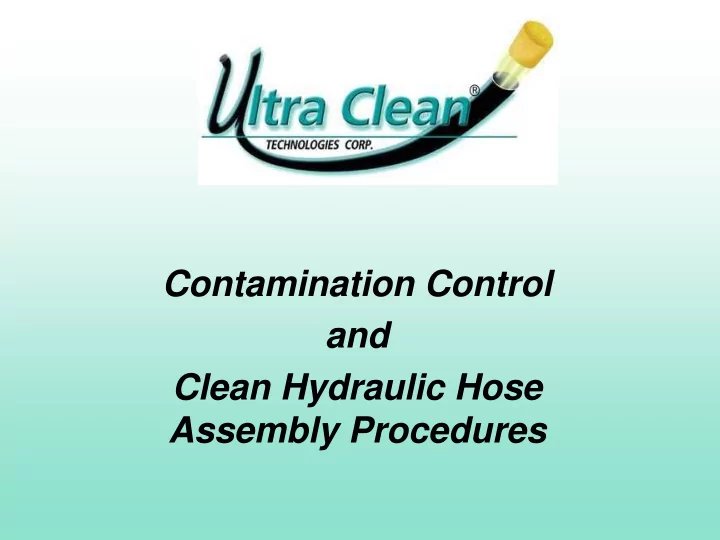

Contamination Control and Clean Hydraulic Hose Assembly Procedures
Ultra Clean Technologies Corp Educational Training for Hose and Tube Fabricators • The Costs of Contamination to your Customer! Video • Waste Management ISO-4406-99 test report • How to minimize failures from occurring with Ultra Clean! ( Clean Hydraulic Hose Assembly Procedures )
The Costs of Contamination
Hose Cleanliness Evaluation Report Conducted by an independent lab … Oilpure Systems • The Hyd. Hose for this test was 1”I.D. X 28” OAL, 4 Spiral with Male Pipe ends. • Abrasive Wheel and Metal Scalloped Blade saws were used to show which blade generates more contamination. Results based on: 1. No cleaning 2. Air blow (10 seconds @ 100PSI) 3. Ultra Clean Procedures and UC style Projectiles
The Cutting Process & Cleaning • The cutting process is the biggest generator of internal contamination to the hydraulic hose assembly. • Two main choices of saw blade types are the abrasive wheel & metal scalloped blade.
Contamination from the Cutting Process 1” I.D. 4 Spiral Hose • Metal Blade • Abrasive Wheel
Unclean Hose vs. Air Blown vs. Ultra Clean
Unclean Hose vs. Air Blown vs. Ultra Clean
Unclean Hose vs. Air Blown vs. Ultra Clean
Unclean Hose vs. Air Blown vs. Ultra Clean
Caterpillar requires all its dealerships to maintain ISO 4406 Contamination Code of 18/16/13 or cleaner in all fluids used in Cat machinery (not just hydraulics). Here is a display at a dealership showing the difference between contamination codes and the amount of dirt they represent (flowing through a pump in one year of operation). 32gpm x 8 hrs x 200 days per year ISO 18/16/13 20lbs per year ISO 23/21/18 630lbs per year 10 second air blow ISO 24/23/19 2560lbs per year
How to Minimize Failures from Occurring with Ultra Clean
3 Main Reasons for Cleaning the Hose Immediately after Cutting • Heat from the cutting process will cause the rubber & metal dust to stick or adhere to the hose tube as it cools. Contamination from freshly cut hose is much easier to remove. • The Hose Stem is difficult to insert over the contamination at each end of the hose, removing the contaminants makes stem insertion easier. • Contamination that is trapped between the hose stem and rubber tube could become an eventual leak path for the hydraulic fluid.
Clean Hose Stem Insertion • The hose stems should be kept in a clean, sealed bag or box until they are ready to become part of the hose assembly.
Lubricating of Hose Stems • Lubricants are generally very contaminated and can re-introduce contamination. • Lubricants may not be compatible with your customers hydraulic fluid or system. • Lubricants may not be necessary if your hose tube has just been cleaned.
Clean Hose Stem Insertion • When is Hose Stem Lubrication Necessary? • When the Tube I.D. is smaller than the Stem O.D. • Reusable and Field Attachable Hose Fittings • Do not apply Lubricant to the Hose Tube • Apply a Clean Lubricant to the Hose Stem O.D. ONLY. ISO-4406-99 Test Results ( With and Without Stem Lubricants) ¾” x 36” 2 wire braided assembly OEM required Cleanliness Level ISO-18-16-14 Contaminated Lubricant-Open Container ISO-19-17-16 UC Procedure - NO Lubrication ISO-17-15-13 4 TIMES CLEANER!!!!!!!
Crimping or Swaging of Hose Stem • The Crimping or Swaging of the Hose Stem causes Stem Deformation. • This is necessary for the proper Coupling Retention. • Stem Deformation causes Metal & Plating Flash Inside of the Stem. • Fire a third UC Projectile through the Assembly • Cap Immediately
Clean Seal Capsules Keep the Assembly CLEAN – Protect the Thread • On and Off quickly. • Will not generate contamination like plastic caps and plugs. • Pre-stacked in stick form so the inside is always CLEAN • Reduced inventory and shipping costs!
Cleaning After the Crimp
Recommend
More recommend